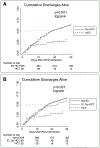High Levels of Morbidity and Mortality Among Pediatric Hematopoietic Cell Transplant Recipients With Severe Sepsis: Insights From the Sepsis PRevalence, OUtcomes, and Therapies International Point Prevalence Study
- PMID: 28926489
- PMCID: PMC7339740
- DOI: 10.1097/PCC.0000000000001338
High Levels of Morbidity and Mortality Among Pediatric Hematopoietic Cell Transplant Recipients With Severe Sepsis: Insights From the Sepsis PRevalence, OUtcomes, and Therapies International Point Prevalence Study
Abstract
Objectives: Pediatric severe sepsis is a major cause of morbidity and mortality worldwide, and hematopoietic cell transplant patients represent a high-risk population. We assessed the epidemiology of severe sepsis in hematopoietic cell transplant patients, describing patient outcomes compared with children with no history of hematopoietic cell transplant.
Design: Secondary analysis of the Sepsis PRevalence, OUtcomes, and Therapies point prevalence study, comparing demographics, sepsis etiology, illness severity, organ dysfunction, and sepsis-related treatments in patients with and without hematopoietic cell transplant. The primary outcome was hospital mortality. Multivariable logistic regression models were used to determine adjusted differences in mortality.
Setting: International; 128 PICUs in 26 countries.
Patients: Pediatric patients with severe sepsis prospectively identified over a 1-year period.
Interventions: None.
Measurements and main results: In patients with severe sepsis, 37/567 (6.5%) had a history of hematopoietic cell transplant. Compared with patients without hematopoietic cell transplant, hematopoietic cell transplant patients had significantly higher hospital mortality (68% vs 23%; p < 0.001). Hematopoietic cell transplant patients were more likely to have hospital acquired sepsis and had more preexisting renal and hepatic dysfunction than non-hematopoietic cell transplant patients with severe sepsis. History of hematopoietic cell transplant, renal replacement therapy, admission from inpatient floor, and number of organ dysfunctions at severe sepsis recognition were independently associated with hospital mortality in multivariable analysis; hematopoietic cell transplant conferred the highest odds of mortality (odds ratio, 4.00; 95% CI, 1.78-8.98). In secondary analysis of hematopoietic cell transplant patients compared with other immunocompromised patients with severe sepsis, history of hematopoietic cell transplant remained independently associated with hospital mortality (odds ratio, 3.03; 95% CI, 1.11-8.27).
Conclusions: In an international study of pediatric severe sepsis, history of hematopoietic cell transplant is associated with a four-fold increased odds of hospital mortality after adjustment for potential measured confounders. Hematopoietic cell transplant patients more often originated from within the hospital compared to children with severe sepsis without hematopoietic cell transplant, possibly providing an earlier opportunity for sepsis recognition and intervention in this high-risk population.
Figures

Comment in
-
The Most Vulnerable SPROUTs: Severe Sepsis in the Pediatric Hematopoietic Cell Transplantation Population.Pediatr Crit Care Med. 2017 Dec;18(12):1179-1180. doi: 10.1097/PCC.0000000000001354. Pediatr Crit Care Med. 2017. PMID: 29206735 No abstract available.
References
-
- Hartman ME, Linde-Zwirble WT, Angus DC, et al.: Trends in the epidemiology of pediatric severe sepsis. Pediatr Crit Care Med 2013; 14:686–693 - PubMed
-
- Watson RS, Carcillo JA: Scope and epidemiology of pediatric sepsis. Pediatr Crit Care Med 2005; 6:S3–S5 - PubMed
-
- Weiss SL, Fitzgerald JC, Pappachan J, et al.; Sepsis Prevalence, Outcomes, and Therapies (SPROUT) Study Investigators and Pediatric Acute Lung Injury and Sepsis Investigators (PALISI) Network: Global epidemiology of pediatric severe sepsis: The sepsis prevalence, outcomes, and therapies study. Am J Respir Crit Care Med 2015; 191:1147–1157 - PMC - PubMed
-
- Nadel S, Goldstein B, Williams MD, et al.; REsearching severe Sepsis and Organ dysfunction in children: a gLobal perspective (RESOLVE) study group: Drotrecogin alfa (activated) in children with severe sepsis: A multicentre phase III randomised controlled trial. Lancet 2007; 369:836–843 - PubMed
Publication types
MeSH terms
Grants and funding
LinkOut - more resources
Full Text Sources
Other Literature Sources
Medical

